task1_1 code

1 #define _CRT_SECURE_NO_WARNINGS 2 #include <stdio.h> 3 #define N 4 4 void test1() { 5 int a[N] = { 1, 9, 8, 4 }; 6 int i; 7 // 输出数组a占用的内存字节数 8 printf("sizeof(a) = %d\n", sizeof(a)); 9 // 输出int类型数组a中每个元素的地址、值 10 for (i = 0; i < N; ++i) 11 printf("%p: %d\n", &a[i], a[i]); 12 // 输出数组名a对应的值 13 printf("a = %p\n", a); 14 } 15 16 void test2() { 17 char b[N] = { '1', '9', '8', '4' }; 18 int i; 19 // 输出数组b占用的内存字节数 20 printf("sizeof(b) = %d\n", sizeof(b)); 21 // 输出char类型数组b中每个元素的地址、值 22 for (i = 0; i < N; ++i) 23 printf("%p: %c\n", &b[i], b[i]); 24 // 输出数组名b对应的值 25 printf("b = %p\n", b); 26 } 27 28 int main() { 29 printf("测试1: int类型一维数组\n"); 30 test1(); 31 printf("\n测试2: char类型一维数组\n"); 32 test2(); 33 return 0; 34 }
task1_1 result
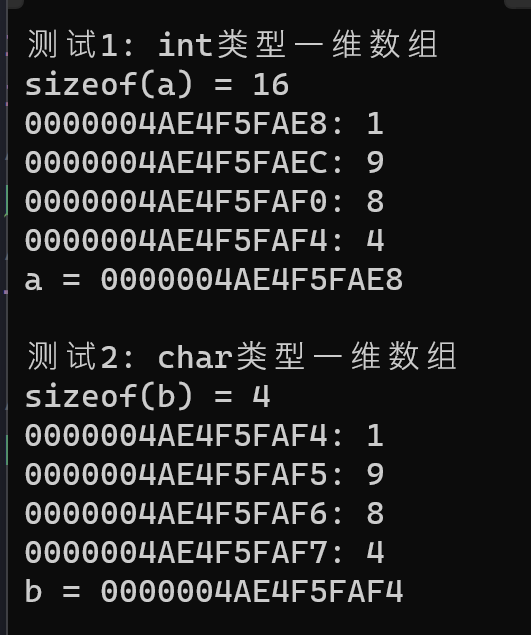
a数组是连续存放的,每个元素占4个字节,a与&a[0]一样。
b数组是连续存放的,每个元素占1个字节,b与&b[o]一样。
task1_2 code

1 #include <stdio.h> 2 #define N 2 3 #define M 4 4 void test1() { 5 int a[N][M] = { {1, 9, 8, 4}, {2, 0, 4, 9} }; 6 int i, j; 7 // 输出int类型二维数组a占用的内存字节数 8 printf("sizeof(a) = %d\n", sizeof(a)); 9 // 输出int类型二维数组a中每个元素的地址、值 10 for (i = 0; i < N; ++i) 11 for (j = 0; j < M; ++j) 12 printf("%p: %d\n", &a[i][j], a[i][j]); 13 printf("\n"); 14 // 输出int类型二维数组名a, 以及,a[0], a[1]的值 15 printf("a = %p\n", a); 16 printf("a[0] = %p\n", a[0]); 17 printf("a[1] = %p\n", a[1]); 18 printf("\n"); 19 } 20 void test2() { 21 char b[N][M] = { {'1', '9', '8', '4'}, {'2', '0', '4', '9'} }; 22 int i, j; 23 // 输出char类型二维数组b占用的内存字节数 24 printf("sizeof(b) = %d\n", sizeof(b)); 25 // 输出char类型二维数组b中每个元素的地址、值 26 for (i = 0; i < N; ++i) 27 for (j = 0; j < M; ++j) 28 printf("%p: %c\n", &b[i][j], b[i][j]); 29 printf("\n"); 30 // 输出char类型二维数组名b, 以及,b[0], b[1]的值 31 printf("b = %p\n", b); 32 printf("b[0] = %p\n", b[0]); 33 printf("b[1] = %p\n", b[1]); 34 } 35 int main() { 36 printf("测试1: int型两维数组"); 37 test1(); 38 printf("\n测试2: char型两维数组"); 39 test2(); 40 return 0; 41 }
task1_2 result
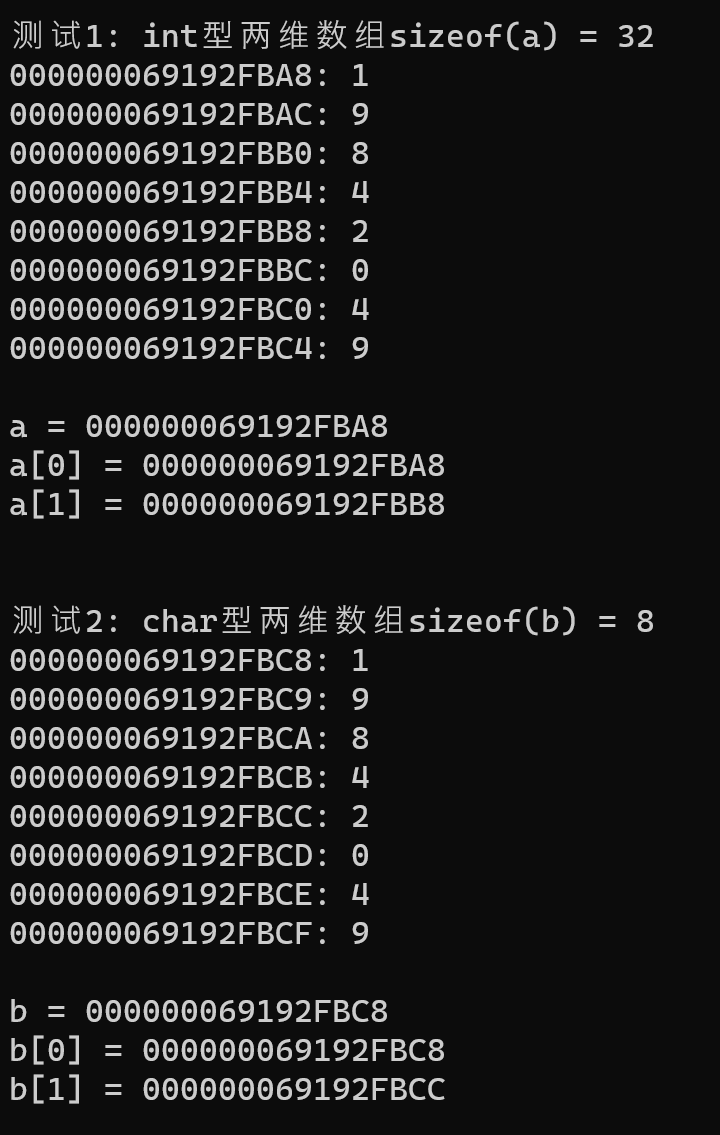
1.是连续存放的,每个占4字节,一样。
2.是连续存放的,每个占1字节,一样。
3.a差16个字节,b差4个字节,都相差一行的字节总数。
task2 code

1 #include <stdio.h> 2 #include <string.h> 3 #define N 80 4 void swap_str(char s1[N], char s2[N]); 5 void test1(); 6 void test2(); 7 int main() { 8 printf("测试1: 用两个一维char数组,实现两个字符串交换\n"); 9 test1(); 10 printf("\n测试2: 用二维char数组,实现两个字符串交换\n"); 11 test2(); 12 return 0; 13 } 14 void test1() { 15 char views1[N] = "hey, C, I hate u."; 16 char views2[N] = "hey, C, I love u."; 17 printf("交换前: \n"); 18 puts(views1); 19 puts(views2); 20 swap_str(views1, views2); 21 printf("交换后: \n"); 22 puts(views1); 23 puts(views2); 24 } 25 void test2() { 26 char views[2][N] = { "hey, C, I hate u.", 27 "hey, C, I love u." }; 28 printf("交换前: \n"); 29 puts(views[0]); 30 puts(views[1]); 31 swap_str(views[0], views[1]); 32 printf("交换后: \n"); 33 puts(views[0]); 34 puts(views[1]); 35 } 36 void swap_str(char s1[N], char s2[N]) { 37 char tmp[N]; 38 strcpy(tmp, s1); 39 strcpy(s1, s2); 40 strcpy(s2, tmp); 41 }
task2 result
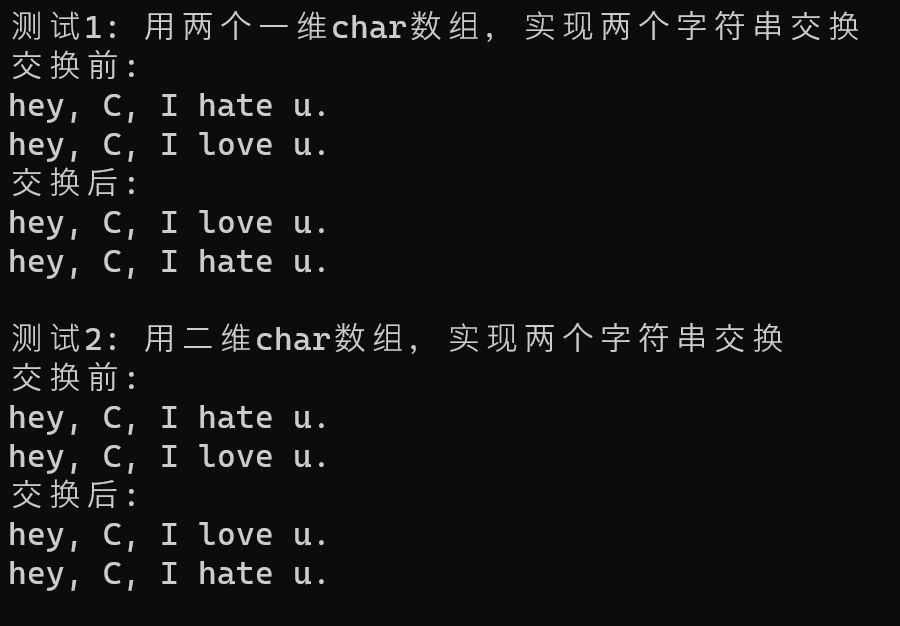
1.不加【】是第一个一维数组第一个char的地址,加【】是 一个二维数组第一行的第一个char的地址。传递的都是地址。
task3_1 code

1 #include <stdio.h> 2 #define N 80 3 int count(char x[]); 4 int main() { 5 char words[N + 1]; 6 int n; 7 while (gets(words) != NULL) { 8 n = count(words); 9 printf("单词数: %d\n\n", n); 10 } 11 return 0; 12 } 13 int count(char x[]) { 14 int i; 15 int word_flag = 0; // 用作单词标志,一个新单词开始,值为1;单词结束,值为0 16 int number = 0; // 统计单词个数 17 for (i = 0; x[i] != '\0'; i++) { 18 if (x[i] == ' ') 19 word_flag = 0; 20 else if (word_flag == 0) { 21 word_flag = 1; 22 number++; 23 } 24 } 25 26 return number; 27 }
task3_1 result
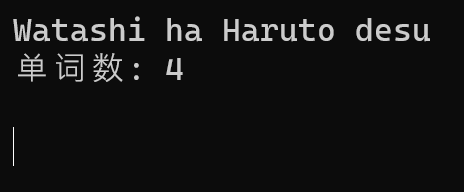
task3_2 code

1 #include <stdio.h> 2 #define N 1000 3 int main() { 4 char line[N]; 5 int word_len; // 记录当前单词长度 6 int max_len; // 记录最长单词长度 7 int end; // 记录最长单词结束位置 8 int i; 9 while (gets(line) != NULL) { 10 word_len = 0; 11 max_len = 0; 12 end = 0; 13 i = 0; 14 while (1) { 15 // 跳过连续空格 16 while (line[i] == ' ') { 17 word_len = 0; // 单词长度置0,为新单词统计做准备 18 i++; 19 } 20 // 在一个单词中,统计当前单词长度 21 while (line[i] != '\0' && line[i] != ' ') { 22 word_len++; 23 i++; 24 } 25 // 更新更长单词长度,并,记录最长单词结束位置 26 if (max_len < word_len) { 27 max_len = word_len; 28 end = i; // end保存的是单词结束的下一个坐标位置 29 } 30 // 遍历到文本结束时,终止循环 31 if (line[i] == '\0') 32 break; 33 } 34 // 输出最长单词 35 printf("最长单词: "); 36 for (i = end - max_len; i < end; ++i) 37 printf("%c", line[i]); 38 printf("\n\n"); 39 } 40 return 0; 41 }
task3_2 result

task4 code

1 #include <stdio.h> 2 #define N 100 3 void dec_to_n(int x, int n); // 函数声明 4 5 int main() { 6 int x; 7 8 printf("输入一个十进制整数: "); 9 while (scanf("%d", &x) != EOF) { 10 dec_to_n(x, 2); 11 dec_to_n(x, 8); 12 dec_to_n(x, 16); 13 printf("\n输入一个十进制整数: "); 14 } 15 16 return 0; 17 } 18 19 void dec_to_n(int x, int n) { 20 int a[N]; 21 char b[N]; 22 int i = 0; 23 int j; 24 25 if (n == 2 || n == 8) { 26 while (x != 0) { 27 a[i] = x % n; 28 x /= n; 29 i++; 30 } 31 for (; i > 0; i--) 32 printf("%d", a[i - 1]); 33 printf("\n"); 34 } 35 else 36 while (x != 0) { 37 if (x % n >= 0 && x % n <= 9) { 38 b[i] = (x % n) + '0'; 39 x /= n; 40 i++; 41 } 42 else { 43 b[i] = (x % n) + 55; 44 x /= n; 45 i++; 46 } 47 } 48 for (; i - 1 >= 0; i--) 49 printf("%c", b[i - 1]); 50 printf("\n"); 51 }
task4 result
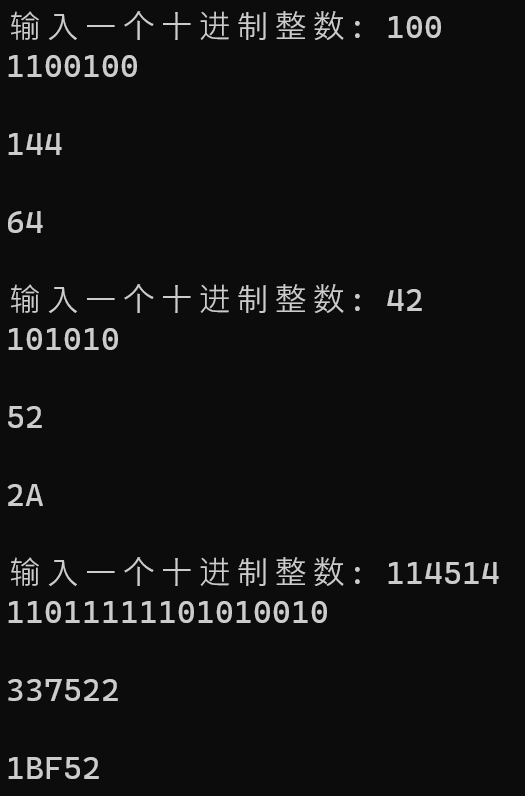
task5 code

1 #include <stdio.h> 2 #define N 5 3 void input(int x[], int n); 4 void output(int x[], int n); 5 double average(int x[], int n); 6 void bubble_sort(int x[], int n); 7 8 int main() { 9 int scores[N]; 10 double ave; 11 printf("录入%d个分数:\n", N); 12 input(scores, N); 13 printf("\n输出课程分数: \n"); 14 output(scores, N); 15 printf("\n课程分数处理: 计算均分、排序...\n"); 16 ave = average(scores, N); 17 bubble_sort(scores, N); 18 printf("\n输出课程均分: %.2f\n", ave); 19 printf("\n输出课程分数(高->低):\n"); 20 output(scores, N); 21 return 0; 22 } 23 24 // 输入n个整数保存到整型数组x中 25 void input(int x[], int n) { 26 int i; 27 for (i = 0; i < n; ++i) 28 scanf("%d", &x[i]); 29 } 30 // 输出整型数组x中n个元素 31 void output(int x[], int n) { 32 int i; 33 for (i = 0; i < n; ++i) 34 printf("%d ", x[i]); 35 printf("\n"); 36 } 37 // 计算整型数组x中n个元素均值,并返回 38 double average(int x[], int n) { 39 double ave = 0; 40 41 for (int i = 0; i < 5; i++) 42 ave += x[i]; 43 44 return ave / 5; 45 } 46 // 对整型数组x中的n个元素降序排序 47 void bubble_sort(int x[], int n) { 48 int i, j, t; 49 50 for (i = 0; i < n - 1; i++) 51 for (j = 0; j < n - 1 - i; j++) 52 if (x[j] < x[j + 1]) { 53 t = x[j]; 54 x[j] = x[j + 1]; 55 x[j + 1] = t; 56 } 57 } 58 */
task5 result
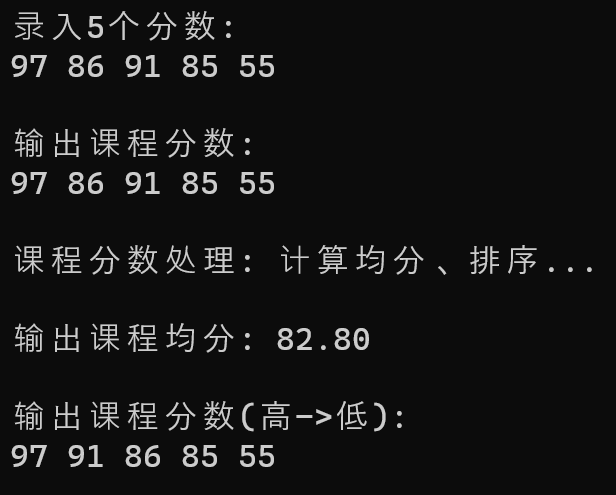
task6 code

1 #include <stdio.h> 2 #include <string.h> 3 #define N 5 4 #define M 20 5 6 void output(char str[][M], int n); 7 void bubble_sort(char str[][M], int n); 8 9 int main() { 10 char name[][M] = { "Bob", "Bill", "Joseph", "Taylor", "George" }; 11 int i; 12 printf("输出初始名单:\n"); 13 output(name, N); 14 printf("\n排序中...\n"); 15 bubble_sort(name, N); // 函数调用 16 printf("\n按字典序输出名单:\n"); 17 output(name, N); 18 return 0; 19 } 20 21 // 功能:按行输出二维数组中的字符串 22 void output(char str[][M], int n) { 23 int i; 24 for (i = 0; i < n; ++i) 25 printf("%s\n", str[i]); 26 } 27 // 功能:使用冒泡排序算法对二维数组str中的n个字符串按字典序排序 28 void bubble_sort(char str[][M], int n) { 29 int i, j, t; 30 char ex[M] = { '0' }; 31 int a; 32 33 for (i = 0; i < n - 1; i++) 34 for (j = 0; j < n - 1 - i; j++) 35 if (strcmp(str[j], str[j + 1]) > 0) { 36 37 38 for (a = 0; a < strlen(str[j]); a++) //confi 39 ex[a] = str[j][a]; 40 41 for (a = 0; a < M; a++) //refresh 42 str[j][a] = '\0'; 43 44 for (a = 0; a < strlen(str[j + 1]); a++) 45 str[j][a] = str[j + 1][a]; 46 for (a = 0; a < strlen(ex); a++) 47 str[j + 1][a] = ex[a]; 48 49 for (a = 0; a < M; a++) //refresh 50 ex[a] = '\0'; 51 52 } 53 }
task6 result

task7 code

1 #include<stdio.h> 2 #include<string.h> 3 #define N 111 4 5 void func(char x[]); 6 7 int main() { 8 char s[N]; 9 10 gets(s); 11 while (s[0] != '\0') { 12 func(s); 13 for (int i = 0; i < N; i++) 14 s[i] = '\0'; 15 gets(s); 16 } 17 18 return 0; 19 } 20 21 void func(char x[]) { 22 int i, j; 23 int flag = 0; 24 25 for (i = 0; i < strlen(x); i++) 26 for (j = i + 1; j < strlen(x); j++) 27 if (x[i] == x[j]) 28 flag++; 29 if (flag > 0) 30 printf("YES\n"); 31 else 32 printf("NO\n"); 33 }
task7 result
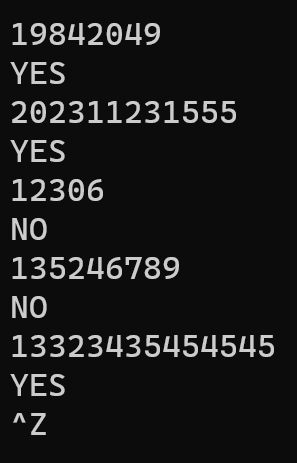
task8 code

1 #include <stdio.h> 2 #define N 100 3 #define M 4 4 5 void output1(int x[][N], int n); 6 void output2(int x[][N]); 7 void rotate_to_right(int x[][N], int n); 8 9 int main() { 10 int t[][N] = { {21, 12, 13, 24}, 11 {25, 16, 47, 38}, 12 {29, 11, 32, 54}, 13 {42, 21, 33, 10} }; 14 15 printf("原始矩阵:\n"); 16 output1(t, M); 17 rotate_to_right(t, M); 18 printf("变换后矩阵:\n"); 19 output2(t); 20 21 return 0; 22 } 23 void output1(int x[][N], int n) { 24 int i, j; 25 for (i = 0; i < n; ++i) { 26 for (j = 0; j < n; ++j) 27 printf("%4d", x[i][j]); 28 printf("\n"); 29 } 30 } 31 void output2(int x[][N]) { 32 int i, j; 33 34 for (i = 0; i < 4; ++i) { 35 for (j = 3; j < 7; ++j) 36 printf("%4d", x[i][j]); 37 printf("\n"); 38 } 39 } 40 41 void rotate_to_right(int x[][N], int n) { 42 int i, j; 43 44 for (i = 0; i < 4; i++) { 45 for (j = 4; j < 8; j++) 46 x[i][j] = x[i][j - 4]; 47 x[i][j + 1] = '\0'; 48 } 49 }
task8 result





